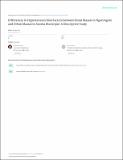| dc.description.abstract | Background: Many ethnic groups within Tanzania are migrating from rural to urban
areas in search of jobs and better livelihoods. One such group is the Maasai, whose
distinct ethnicity and lifestyle potentially offers significant learnings in hypertensionrelated
population health. This project investigated potential risk factors for hypertension
in two Maasai settings with contrasting lifestyles: rural Ngorongoro Conservation Area
and urban Arusha Municipal.
Methods: A cross-sectional descriptive study in three rural villages (i.e., Olbalba,
Misigiyo, Alelilayi) and urban Arusha Municipal, sampling 724 individuals aged 18 to 75
years, ( i . e. , 3 35 males; 389 females). Quantitative measurements included blood
pressure, body mass index (BMI), waist to hip ratio (WHR), total cholesterol, alcohol consumption, cigarette/tobacco use, and level of physical activity. Qualitative
measurements included self-reports of lifestyle related risk factors such as distance
walked, daily meal frequencies, alcohol and cigarette/tobacco use.
Results: Prevalence of hypertension in urban Maasai 27.7% (n=97) was significantly
higher (p<0.0001) than for rural Maasai 10.9% (n=41). Systolic blood pressure in
urban Maasai was significantly positively correlated with obesity parameters including
BMI, weight, waist- circumference, hip circumference and WHR while distance walked
was significantly (p=0.004) negatively associated. In urban Maasai, hypertension
prevalence increased with age being highest at 60 years and above. Gender
differences were apparent between 40-59 years where prevalence in urban males was
significantly higher than females. Compared to rural counterparts, urban Maasai were
significantly higher (p<0.05) for overweight, number of daily meals consumed, alcohol
use, and less physical activity. No difference occurred across sites with respect to
WHR and total cholesterol. For rural Maasai, systolic blood pressure was only
significantly (p<0.0033) positively associated with BMI. In contrast to urban Maasai,
prevalence of hypertension amongst rural Maasai decreased with increasing age and,
furthermore, there were no gender differences across age.
Conclusions: The unique lower hypertension pattern for rural Maasai may reflect a
number of emerging environmental and life style factors. Amongst rural Maasai, a
distinctive pattern emerged of underweight, low WHR, lower meal consumption
frequency, and more physical activities. Urban Maasai showed higher prevalence of
hypertension and it risk factors compared to their rural counterparts. Findings
emphasized the need for hypertension prevention lifestyle programmes including
ongoing monitoring of blood pressure trends within the Maasai, especially within the
context of urbanization. | en_US |

